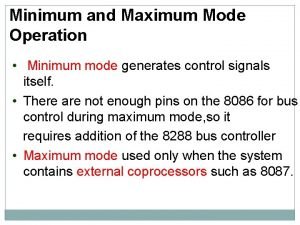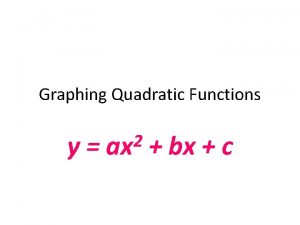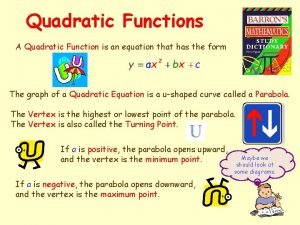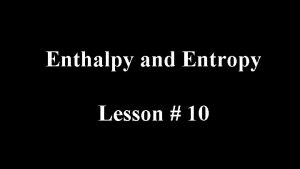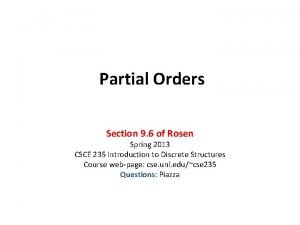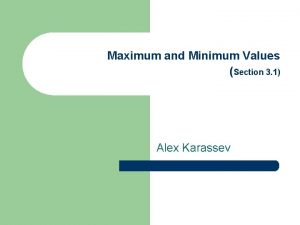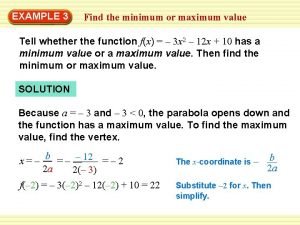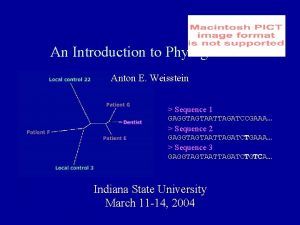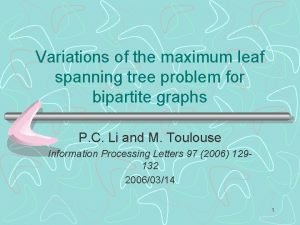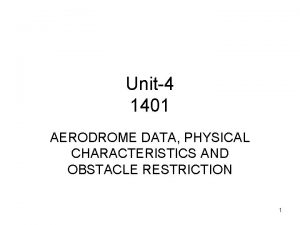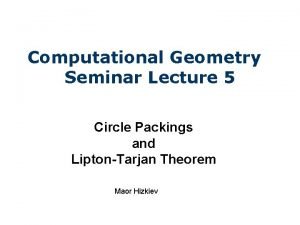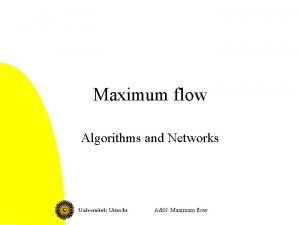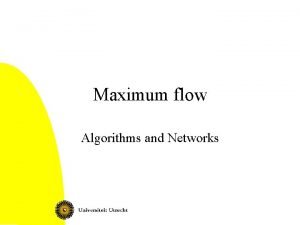Maximum packings and minimum coverings of multigraphs with







![Abueida and Daven [3] investigated the problem of (Kk, Sk)-decomposition of the complete graph Abueida and Daven [3] investigated the problem of (Kk, Sk)-decomposition of the complete graph](https://slidetodoc.com/presentation_image_h2/eaab952a16d304fc9963c1409173ed16/image-8.jpg)
![Priyadharsini and Muthusamy [15, 16] gave necessary and sufficient conditions for the existence of Priyadharsini and Muthusamy [15, 16] gave necessary and sufficient conditions for the existence of](https://slidetodoc.com/presentation_image_h2/eaab952a16d304fc9963c1409173ed16/image-9.jpg)
![Abueida and Daven [2] and Abueida, Daven and Roblee [5] completely determined the values Abueida and Daven [2] and Abueida, Daven and Roblee [5] completely determined the values](https://slidetodoc.com/presentation_image_h2/eaab952a16d304fc9963c1409173ed16/image-10.jpg)
![Abueida, Clark and Leach [1] and Abueida and Hampson [6] considered the existence of Abueida, Clark and Leach [1] and Abueida and Hampson [6] considered the existence of](https://slidetodoc.com/presentation_image_h2/eaab952a16d304fc9963c1409173ed16/image-11.jpg)
![In [18, 19], Shyu considered the existence of a decomposition of Kn into paths In [18, 19], Shyu considered the existence of a decomposition of Kn into paths](https://slidetodoc.com/presentation_image_h2/eaab952a16d304fc9963c1409173ed16/image-12.jpg)
![In [21], Shyu considered the existence of a decomposition of Km, n into paths In [21], Shyu considered the existence of a decomposition of Km, n into paths](https://slidetodoc.com/presentation_image_h2/eaab952a16d304fc9963c1409173ed16/image-13.jpg)



![Abueida and Daven [3] obtained the maximum packing and the minimum covering of the Abueida and Daven [3] obtained the maximum packing and the minimum covering of the](https://slidetodoc.com/presentation_image_h2/eaab952a16d304fc9963c1409173ed16/image-17.jpg)


![G[U] : the subgraph of G induced by U. G[U, W] : the maximal G[U] : the subgraph of G induced by U. G[U, W] : the maximal](https://slidetodoc.com/presentation_image_h2/eaab952a16d304fc9963c1409173ed16/image-20.jpg)

![Proposition 2. 2. [8] J. Bosák, Decompositions of Graphs, Kluwer, Dordrecht, Netherlands, 1990. [10] Proposition 2. 2. [8] J. Bosák, Decompositions of Graphs, Kluwer, Dordrecht, Netherlands, 1990. [10]](https://slidetodoc.com/presentation_image_h2/eaab952a16d304fc9963c1409173ed16/image-22.jpg)






![Proposition 3. 1. [11] D. G. Hoffman, The real truth about star designs, Discrete Proposition 3. 1. [11] D. G. Hoffman, The real truth about star designs, Discrete](https://slidetodoc.com/presentation_image_h2/eaab952a16d304fc9963c1409173ed16/image-29.jpg)





![[1] A. Abueida, S. Clark, and D. Leach, Multidecomposition of the complete graph into [1] A. Abueida, S. Clark, and D. Leach, Multidecomposition of the complete graph into](https://slidetodoc.com/presentation_image_h2/eaab952a16d304fc9963c1409173ed16/image-35.jpg)
![[9] Darryn Bryant, Packing paths in complete graphs, J. Combin. Theory Ser. B 100 [9] Darryn Bryant, Packing paths in complete graphs, J. Combin. Theory Ser. B 100](https://slidetodoc.com/presentation_image_h2/eaab952a16d304fc9963c1409173ed16/image-36.jpg)
![[17] T. -W. Shyu, Decomposition of complete graphs into paths and stars, Discrete Math. [17] T. -W. Shyu, Decomposition of complete graphs into paths and stars, Discrete Math.](https://slidetodoc.com/presentation_image_h2/eaab952a16d304fc9963c1409173ed16/image-37.jpg)

- Slides: 38

Maximum packings and minimum coverings of multigraphs with paths and stars Hung-Chih Lee Department of Information Technology Ling Tung University Chun-Cheng Chen Department of Mathematics National Central University 1

Outline Introduction Packing and covering of λKn, n 2

Introduction Kn : the complete graph with n vertices. Km, n : the complete bipartite graph with parts of sizes m and n. If m = n, the complete bipartite graph is referred to as balanced. Sk (k-star) : the complete bipartite graph K 1, k. Pk (k-path) : a path on k vertices. Ck (k-cycle) : a cycle of length k. 3

λH : the multigraph obtained from H by replacing each edge e by λ edges each having the same endpoints as e. When λ = 1, 1 H is simply written as H. A decomposition of H : a set of edge-disjoint subgraphs of H whose union is H. A G-decomposition of H : a decomposition of H in which each subgraph is isomorphic to G. If H has a G-decomposition, we say that H is Gdecomposable and write G|H. 4

Example. K 6 K 3, 4 P 4|K 6 S 3|K 3, 4 5

An (F, G)-decomposition of H : a decomposition of H into copies of F and G using at least one of each. If H has an (F, G)-decomposition, we say that H is (F, G)-decomposable and write (F, G)|H. 6

Example. K 6 K 3, 4 (P 4, S 3)|K 6 (P 4, S 3)|K 3, 4 7
![Abueida and Daven 3 investigated the problem of Kk Skdecomposition of the complete graph Abueida and Daven [3] investigated the problem of (Kk, Sk)-decomposition of the complete graph](https://slidetodoc.com/presentation_image_h2/eaab952a16d304fc9963c1409173ed16/image-8.jpg)
Abueida and Daven [3] investigated the problem of (Kk, Sk)-decomposition of the complete graph Kn. [3] A. Abueida and M. Daven, Multidecompositons of the complete graph, Ars Combin. 72(2004), 17 -22. Abueida and Daven [4] investigated the problem of the (C 4, E 2)-decomposition of several graph products where E 2 denotes two vertex disjoint edges. [4] A. Abueida and M. Daven, Multidecompositions of several graph products, Graphs Combin. 29 (2013), 315 -326. Abueida and O‘Neil [7] settled the existence problem for (Ck, Sk-1)-decomposition of the complete multigraph λKn for k ∈ {3, 4, 5}. [7] A. Abueida and T. O'Neil, Multidecomposition of λKm into small cycles and claws, Bull. Inst. Combin. Appl. 49 (2007), 32 -40. 8
![Priyadharsini and Muthusamy 15 16 gave necessary and sufficient conditions for the existence of Priyadharsini and Muthusamy [15, 16] gave necessary and sufficient conditions for the existence of](https://slidetodoc.com/presentation_image_h2/eaab952a16d304fc9963c1409173ed16/image-9.jpg)
Priyadharsini and Muthusamy [15, 16] gave necessary and sufficient conditions for the existence of (Gn, Hn)-decompositions of λKn and λKn, n where Gn, Hn ∈ {Cn, Pn, Sn-1}. [15] H. M. Priyadharsini and A. Muthusamy, (Gm, Hm)-multifactorization of λKm, J. Com-bin. Math. Combin. Comput. 69 (2009), 145 -150. [16] H. M. Priyadharsini and A. Muthusamy, (Gm, Hm)-multidecomposition of Km, m(λ), Bull. Inst. Combin. Appl. 66 (2012), 42 -48. 9
![Abueida and Daven 2 and Abueida Daven and Roblee 5 completely determined the values Abueida and Daven [2] and Abueida, Daven and Roblee [5] completely determined the values](https://slidetodoc.com/presentation_image_h2/eaab952a16d304fc9963c1409173ed16/image-10.jpg)
Abueida and Daven [2] and Abueida, Daven and Roblee [5] completely determined the values of n for which λKn admits a (G, H)-decomposition where (G, H) is a graph-pair of order 4 or 5. [2] A. Abueida and M. Daven, Multidesigns for graph-pairs of order 4 and 5, Graphs Com-bin. 19 (2003), 433 -447. [5] A. Abueida, M. Daven, and K. J. Roblee, Multidesigns of the λ-fold complete graph for graph-pairs of order 4 and 5, Australas J. Combin. 32 (2005), 125 -136. 10
![Abueida Clark and Leach 1 and Abueida and Hampson 6 considered the existence of Abueida, Clark and Leach [1] and Abueida and Hampson [6] considered the existence of](https://slidetodoc.com/presentation_image_h2/eaab952a16d304fc9963c1409173ed16/image-11.jpg)
Abueida, Clark and Leach [1] and Abueida and Hampson [6] considered the existence of decompositions of Kn−F for the graph-pair of order 4 and 5, respectively, where F is a Hamiltonian cycle, a 1 -factor, or almost 1 -factor. [1] A. Abueida, S. Clark, and D. Leach, Multidecomposition of the complete graph into graph pairs of order 4 with various leaves, Ars Combin. 93 (2009), 403 -407. [6] A. Abueida and C. Hampson, Multidecomposition of Kn − F into graph-pairs of order 5 where F is a Hamilton cycle or an (almost) 1 -factor, Ars Combin. 97 (2010), 399 -416 Shyu [17] investigated the problem of decomposing Kn into paths and stars with k edges, giving a necessary and sufficient condition for k = 3. [17] T. -W. Shyu, Decomposition of complete graphs into paths and stars, Discrete Math. 310 (2010), 2164 -2169. 11
![In 18 19 Shyu considered the existence of a decomposition of Kn into paths In [18, 19], Shyu considered the existence of a decomposition of Kn into paths](https://slidetodoc.com/presentation_image_h2/eaab952a16d304fc9963c1409173ed16/image-12.jpg)
In [18, 19], Shyu considered the existence of a decomposition of Kn into paths and cycles with k edges, giving a necessary and sufficient condition for k ∈ { 3, 4}. [18] T. -W. Shyu, Decompositions of complete graphs into paths and cycles, Ars Combin. 97(2010), 257 -270. [19] T. -W. Shyu, Decomposition of complete graphs into paths of length three and triangles, Ars Combin. 107 (2012), 209 -224. Shyu [20] investigated the problem of decomposing Kn into cycles and stars with k edges, settling the case k = 4. [20] T. -W. Shyu, Decomposition of complete graphs into cycles and stars, Graphs Combin. 29 (2013), 301 -313. 12
![In 21 Shyu considered the existence of a decomposition of Km n into paths In [21], Shyu considered the existence of a decomposition of Km, n into paths](https://slidetodoc.com/presentation_image_h2/eaab952a16d304fc9963c1409173ed16/image-13.jpg)
In [21], Shyu considered the existence of a decomposition of Km, n into paths and stars with k edges, giving a necessary and sufficient condition for k = 3. [21] T. -W. Shyu, Decomposition of complete bipartite graphs into paths and stars with same number of edges, Discrete Math. 313 (2013), 865 -871. Lee [12] and Lee and Lin [13] established necessary and sufficient conditions for the existence of (Ck, Sk)decompositions of the complete bipartite graph and the complete bipartite graph with a 1 -factor removed, respectively. [12] H. -C. Lee, Multidecompositions of complete bipartite graphs into cycles and stars, Ars Combin. 108 (2013), 355 -364. [13] H. -C. Lee and J. -J. Lin, Decomposition of the complete bipartite graph with a 1 factor removed into cycles and stars, Discrete Math. 313 (2013), 2354 -2358. 13

When a multigraph H does not admit an (F, G)decomposition, two natural questions arise : (1) What is the minimum number of edges needed to be removed from the edge set of H so that the resulting graph is (F, G)-decomposable? (2) What is the minimum number of edges needed to be added to the edge set of H so that the resulting graph is (F, G)-decomposable? These questions are respectively called the maximum packing problem and the minimum covering problem of H with F and G. 14

Let F, G, and H be multigraphs. For subgraphs L and R of H. An (F, G)-packing ((F, G)-covering) of H with leave L (padding R) is an (F, G)-decomposition of H−E(L) (H+E(R)). An (F, G)-packing ((F, G)-covering) of H with the largest (smallest) cardinality is a maximum (F, G)-packing (minimum (F, G)-covering) of H, and its cardinality is the (F, G)-packing number ((F, G)-covering number) of H, denoted by p(H; F, G) (c(H; F, G)). An (F, G)-decomposition of H is a maximum (F, G)-packing (minimum (F, G)-covering) with leave (padding) the empty graph. 15

Example. K 6 (P 5, S 4)|K 6 –E(P 4) (P 5, S 4)|K 6 +E(P 2) 16
![Abueida and Daven 3 obtained the maximum packing and the minimum covering of the Abueida and Daven [3] obtained the maximum packing and the minimum covering of the](https://slidetodoc.com/presentation_image_h2/eaab952a16d304fc9963c1409173ed16/image-17.jpg)
Abueida and Daven [3] obtained the maximum packing and the minimum covering of the complete graph Kn with (Kk, Sk). [3] A. Abueida and M. Daven, Multidecompositons of the complete graph, Ars Combin. 72(2004), 17 -22. Abueida and Daven [2] and Abueida, Daven and Roblee [5] gave the maximum packing and the minimum covering of Kn and λKn with G and H, respectively, where (G, H) is a graph-pair of order 4 or 5. [2] A. Abueida and M. Daven, Multidesigns for graph-pairs of order 4 and 5, Graphs Com-bin. 19 (2003), 433 -447. [5] A. Abueida, M. Daven, and K. J. Roblee, Multidesigns of the λ-fold complete graph for graph-pairs of order 4 and 5, Australas J. Combin. 32 (2005), 125 -136. 17

Packing and covering of λKn Let G be a multigraph. The degree of a vertex x of G (deg. G(x)) : the number of edges incident with x. The center of Sk : the vertex of degree k in Sk. The endvertex of Sk : the vertex of degree 1 in Sk. (x; y 1, y 2, …, yk) : the Sk with center x and endvertices y 1, y 2, …, yk. 19

v 1 v 2… vk : the Pk through vertices v 1, v 2, …, vk in order, and the vertices v 1 and vk are referred to as its origin and terminus. If P = x 1 x 2…xt, Q = y 1 y 2…ys and xt = y 1, then P + Q = x 1 x 2…xty 2…ys. Pk(v 1, vk) : a Pk with origin v 1 and terminus vk. 20
![GU the subgraph of G induced by U GU W the maximal G[U] : the subgraph of G induced by U. G[U, W] : the maximal](https://slidetodoc.com/presentation_image_h2/eaab952a16d304fc9963c1409173ed16/image-20.jpg)
G[U] : the subgraph of G induced by U. G[U, W] : the maximal bipartite subgraph of G with bipartition (U, W). When G 1, G 2, …, Gt are multigraphs, not necessarily disjoint. 21

Proposition 2. 1. For positive integers λ, n, and t, and any sequence m 1, m 2, …, mt of positive integers, the complete multigraph λKn can be decomposed into paths of lengths m 1, m 2, …, mt if and only if mi ≤ n-1 and m 1+m 2+…+mt = |E(λKn)|. [9] Darryn Bryant, Packing paths in complete graphs, J. Combin. Theory Ser. B 100 (2010), 206 -215. 22
![Proposition 2 2 8 J Bosák Decompositions of Graphs Kluwer Dordrecht Netherlands 1990 10 Proposition 2. 2. [8] J. Bosák, Decompositions of Graphs, Kluwer, Dordrecht, Netherlands, 1990. [10]](https://slidetodoc.com/presentation_image_h2/eaab952a16d304fc9963c1409173ed16/image-22.jpg)
Proposition 2. 2. [8] J. Bosák, Decompositions of Graphs, Kluwer, Dordrecht, Netherlands, 1990. [10] P. Hell and A. Rosa, Graph decompositions, handcuffed prisoners and balanced P-designs, Discrete Math. 2 (1972), 229 -252. 23

Theorem 2. 5. Let n and k be positive integers and let t be a nonnegative integer with k ≥ 3, n ≥ k + 2, and t ≤ k-1. If |E(Kn)| ≡ t (mod k), then Kn has a (Pk+1, Sk)-packing with leave Pt+1. Proof. Let n = qk+r and |E(Kn)| = pk+t with integers q, p, r and 0 ≤ r ≤ k -1. Now we consider the case r ≠ 1, we set n = m + sk + 1 where m and s are positive integers with 1 ≤ m ≤ k-1. Case 1. m is odd. Case 2. m is even. 25

Case 2. m is even. Proposition 2. 1. Lemma 2. 4. For positive integers Proposition 2. 2. λ, n, and t, and any sequence m 1, m 2, …, mt of positive integers, the complete multigraph λKn can be decomposed into paths of lengths m 1, m 2, …, mt if and only if mi ≤ n-1 and m 1+ m 2+…+mt = |E(λKn)|. … Ksk+1 Sk|K 1, sk Pk+1 Km Sk|K 1, sk … … 30

Theorem 2. 6. Let λ, n and k be positive integers and let t be a nonnegative integer with k ≥ 3, n ≥ k+2, and t ≤ k-1. If |E(λKn)| ≡ t (mod k), then λKn has a (Pk+1, Sk)-packing with leave Pt+1. 31

Corollary 2. 7. 33

For positive integers k, n, and t with k ≤ n-1 and t ≤ k-1. If λKn has a (Pk+1, Sk)-packing with leave Pt+1, then it has a (Pk+1, Sk)covering with padding Pk-t+1. Theorem 2. 8. 38

Packing and covering of λKn, n (v 1, v 2, …, vk) : the k-cycle of G through vertices v 1, v 2, …, vk in order. μ(uv) : the number of edges of G joining u and v. A central function c from V(G) to the set of nonnegative integers is defined as follows : for each v∈ V(G), c(v) is the number of Sk in the decomposition whose center is v. 39
![Proposition 3 1 11 D G Hoffman The real truth about star designs Discrete Proposition 3. 1. [11] D. G. Hoffman, The real truth about star designs, Discrete](https://slidetodoc.com/presentation_image_h2/eaab952a16d304fc9963c1409173ed16/image-29.jpg)
Proposition 3. 1. [11] D. G. Hoffman, The real truth about star designs, Discrete Math. 284 (2004), 177 -180. 40

Lemma 3. 4. Lemma 3. 6. 44

Proof of Lemma 3. 4. Let n = k + r. The assumption k < n < 2 k implies 0 < r < k. Packing. Lemma 3. 3. If λ and k are positive integers with k ≥ 2, then λKk, k is (Pk+1, Sk)decomposable. By Lemma 3. 3. ⇒ (Pk+1, Sk) |Kk, k leave 45

Covering Define a (k + 1)-path P as follows: H = λK λ n, n - E(P) + E(P’). … … P P’ … … k is odd. … … s is odd. … … … … 46

Claim. Sk|H Proposition 3. 1. 47

Theorem 3. 7. Corollary 3. 8. 48
![1 A Abueida S Clark and D Leach Multidecomposition of the complete graph into [1] A. Abueida, S. Clark, and D. Leach, Multidecomposition of the complete graph into](https://slidetodoc.com/presentation_image_h2/eaab952a16d304fc9963c1409173ed16/image-35.jpg)
[1] A. Abueida, S. Clark, and D. Leach, Multidecomposition of the complete graph into graph pairs of order 4 with various leaves, Ars Combin. 93 (2009), 403 -407. [2] A. Abueida and M. Daven, Multidesigns for graph-pairs of order 4 and 5, Graphs Com-bin. 19 (2003), 433 -447. [3] A. Abueida and M. Daven, Multidecompositons of the complete graph, Ars Combin. 72(2004), 17 -22. [4] A. Abueida and M. Daven, Multidecompositions of several graph products, Graphs Combin. 29 (2013), 315 -326. [5] A. Abueida, M. Daven, and K. J. Roblee, Multidesigns of the λ-fold complete graph for graph-pairs of order 4 and 5, Australas J. Combin. 32 (2005), 125 -136. [6] A. Abueida and C. Hampson, Multidecomposition of Kn − F into graph-pairs of order 5 where F is a Hamilton cycle or an (almost) 1 -factor, Ars Combin. 97 (2010), 399 -416 [7] A. Abueida and T. O'Neil, Multidecomposition of λKm into small cycles and claws, Bull. Inst. Combin. Appl. 49 (2007), 32 -40. [8] J. Bosák, Decompositions of Graphs, Kluwer, Dordrecht, Netherlands, 1990.
![9 Darryn Bryant Packing paths in complete graphs J Combin Theory Ser B 100 [9] Darryn Bryant, Packing paths in complete graphs, J. Combin. Theory Ser. B 100](https://slidetodoc.com/presentation_image_h2/eaab952a16d304fc9963c1409173ed16/image-36.jpg)
[9] Darryn Bryant, Packing paths in complete graphs, J. Combin. Theory Ser. B 100 (2010), 206 -215. [10] P. Hell and A. Rosa, Graph decompositions, handcuffed prisoners and balanced P-designs, Discrete Math. 2 (1972), 229 -252. [11] D. G. Hoffman, The real truth about star designs, Discrete Math. 284 (2004), 177 -180. [12] H. -C. Lee, Multidecompositions of complete bipartite graphs into cycles and stars, Ars Combin. 108 (2013), 355 -364. [13] H. -C. Lee and J. -J. Lin, Decomposition of the complete bipartite graph with a 1 factor removed into cycles and stars, Discrete Math. 313 (2013), 2354 -2358. [14] C. A. Parker, Complete bipartite graph path decompositions, Ph. D. Thesis, Auburn Uni-versity, Auburn, Alabama, 1998. [15] H. M. Priyadharsini and A. Muthusamy, (Gm, Hm)-multifactorization of λKm, J. Com-bin. Math. Combin. Comput. 69 (2009), 145 -150. [16] H. M. Priyadharsini and A. Muthusamy, (Gm, Hm)-multidecomposition of Km, m(λ), Bull. Inst. Combin. Appl. 66 (2012), 42 -48.
![17 T W Shyu Decomposition of complete graphs into paths and stars Discrete Math [17] T. -W. Shyu, Decomposition of complete graphs into paths and stars, Discrete Math.](https://slidetodoc.com/presentation_image_h2/eaab952a16d304fc9963c1409173ed16/image-37.jpg)
[17] T. -W. Shyu, Decomposition of complete graphs into paths and stars, Discrete Math. 310 (2010), 2164 -2169. [18] T. -W. Shyu, Decompositions of complete graphs into paths and cycles, Ars Combin. 97(2010), 257 -270. [19] T. -W. Shyu, Decomposition of complete graphs into paths of length three and triangles, Ars Combin. 107 (2012), 209 -224. [20] T. -W. Shyu, Decomposition of complete graphs into cycles and stars, Graphs Combin. 29 (2013), 301 -313. [21] T. -W. Shyu, Decomposition of complete bipartite graphs into paths and stars with same number of edges, Discrete Math. 313 (2013), 865 -871.

Thank you for your listening. 52
 Local max
Local max Minimum mode of 8086
Minimum mode of 8086 Max/min word problems
Max/min word problems Quadratic function maximum
Quadratic function maximum Optimization problems maximum and minimum
Optimization problems maximum and minimum Ax2+bx+c graph
Ax2+bx+c graph Derivative maximum and minimum
Derivative maximum and minimum Extreme value theorem
Extreme value theorem Maxima minima of quadratic equation
Maxima minima of quadratic equation Undefined quadratic equation
Undefined quadratic equation Transition fit diagram
Transition fit diagram Maximum metal condition
Maximum metal condition Minimum enthalpy maximum entropy
Minimum enthalpy maximum entropy Bellani-six thermometer.
Bellani-six thermometer. Partial order
Partial order Coverings of kidney
Coverings of kidney Dura arachnoid pia
Dura arachnoid pia Cross section of cerebrum
Cross section of cerebrum Two kidneys
Two kidneys Isthmus size
Isthmus size Vaginal hydrocele
Vaginal hydrocele Body coverings of animals
Body coverings of animals Epididis
Epididis Conjoint tendon
Conjoint tendon Cara mencari nilai minimum
Cara mencari nilai minimum Minimum maximum value
Minimum maximum value Minimum maximum value
Minimum maximum value Maximum likelihood vs maximum parsimony
Maximum likelihood vs maximum parsimony Maximum likelihood vs maximum parsimony
Maximum likelihood vs maximum parsimony Minimum price advantages and disadvantages
Minimum price advantages and disadvantages Datum shift
Datum shift Welding symbol
Welding symbol Minimum resolvable acuity
Minimum resolvable acuity Gearless vs geared elevator
Gearless vs geared elevator Minimum leaf spanning tree
Minimum leaf spanning tree Aerodrome data
Aerodrome data Flight duty period
Flight duty period Stalni vjetrovi na zemlji
Stalni vjetrovi na zemlji Word count for iwa ap seminar
Word count for iwa ap seminar

